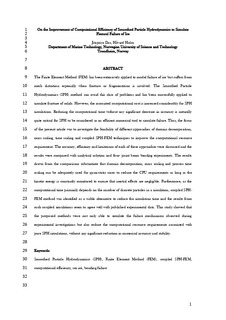| dc.contributor.author | Das, Jitapriya | |
| dc.contributor.author | Holm, Håvard | |
| dc.date.accessioned | 2019-04-12T07:34:44Z | |
| dc.date.available | 2019-04-12T07:34:44Z | |
| dc.date.created | 2018-04-24T18:10:31Z | |
| dc.date.issued | 2018 | |
| dc.identifier.citation | Journal of Ocean Engineering and Marine Energy. 2018, 4 (2), 153-169. | nb_NO |
| dc.identifier.issn | 2198-6444 | |
| dc.identifier.uri | http://hdl.handle.net/11250/2594373 | |
| dc.description.abstract | The finite element method (FEM) has been extensively applied to model failure of ice but suffers from mesh distortion especially when fracture or fragmentation is involved. The smoothed particle hydrodynamics (SPH) method can avoid this class of problems and has been successfully applied to simulate fracture of solids. However, the associated computational cost is increased considerably for SPH simulations. Reducing the computational time without any significant decrease in accuracy is naturally quite critical for SPH to be considered as an efficient numerical tool to simulate failure. Thus, the focus of the present article was to investigate the feasibility of different approaches of domain decomposition, mass scaling, time scaling and coupled SPH–FEM techniques to improve the computational resource requirement. The accuracy, efficiency and limitations of each of these approaches were discussed and the results were compared with analytical solution and four-point beam bending experiments. The results drawn from the comparisons substantiate that domain decomposition, mass scaling and process time scaling can be adequately used for quasi-static cases to reduce the CPU requirements as long as the kinetic energy is constantly monitored to ensure that inertial effects are negligible. Furthermore, as the computational time primarily depends on the number of discrete particles in a simulation, coupled SPH–FEM method was identified as a viable alternative to reduce the simulation time and the results from such coupled simulations seem to agree well with the published experimental data. This study showed that the proposed methods were not only able to emulate the failure mechanisms observed during the experimental investigations but also reduce the computational resource requirements associated with pure SPH simulations, without any significant reduction in numerical accuracy and stability. | nb_NO |
| dc.language.iso | eng | nb_NO |
| dc.publisher | Springer Verlag | nb_NO |
| dc.title | On the improvement of computational efficiency of smoothed particle hydrodynamics to simulate flexural failure of ice | nb_NO |
| dc.type | Journal article | nb_NO |
| dc.type | Peer reviewed | nb_NO |
| dc.description.version | acceptedVersion | nb_NO |
| dc.source.pagenumber | 153-169 | nb_NO |
| dc.source.volume | 4 | nb_NO |
| dc.source.journal | Journal of Ocean Engineering and Marine Energy | nb_NO |
| dc.source.issue | 2 | nb_NO |
| dc.identifier.doi | 10.1007/s40722-018-0114-1 | |
| dc.identifier.cristin | 1581375 | |
| dc.description.localcode | This is a post-peer-review, pre-copyedit version of an article published in [Journal of Ocean Engineering and Marine Energy]. The final authenticated version is available online at: https://doi.org/10.1007/s40722-018-0114-1 | nb_NO |
| cristin.unitcode | 194,64,20,0 | |
| cristin.unitname | Institutt for marin teknikk | |
| cristin.ispublished | true | |
| cristin.fulltext | postprint | |
| cristin.qualitycode | 1 | |
